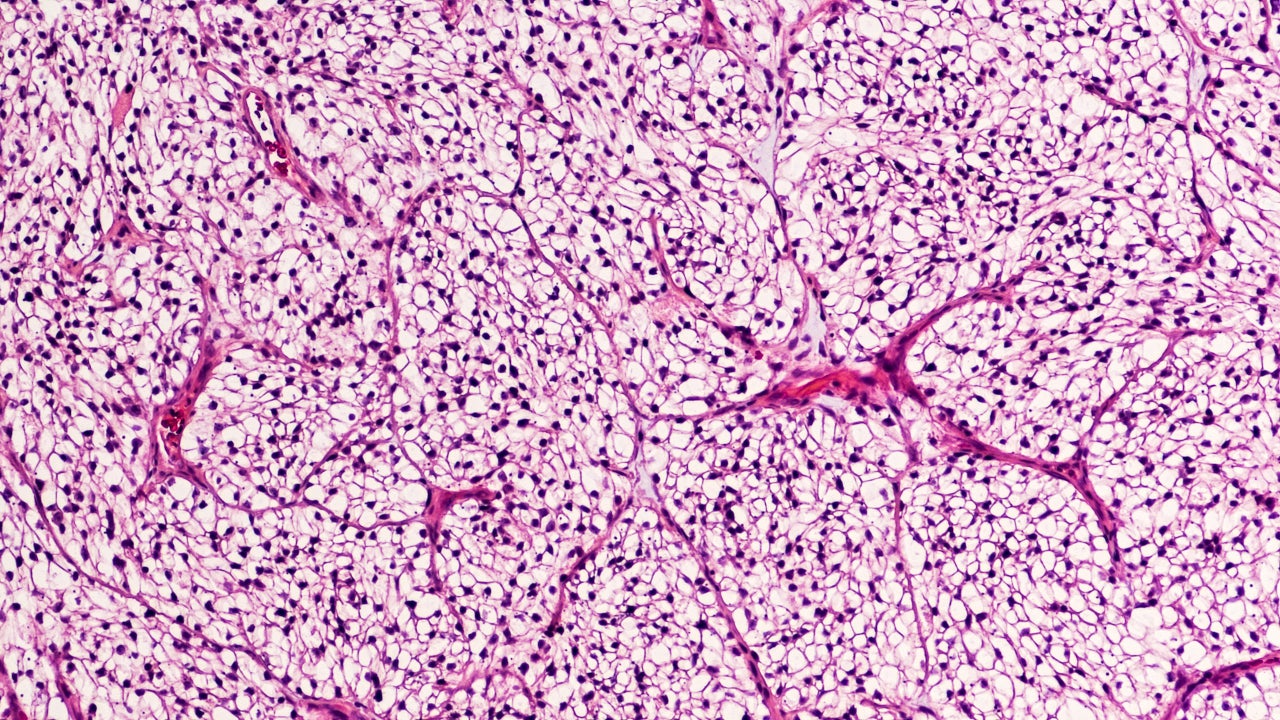
Merck’s Keytruda (pembrolizumab) move into earlier lines of therapy for renal cell carcinoma (RCC) could nonetheless keep open the possibility for its use in frontline treatment for metastatic disease, experts said.
Positive data from the Phase III KEYNOTE-564 evaluating adjuvant Keytruda use will likely have a practice-changing impact, experts said, following a likely FDA approval. The data was part of the plenary presentation at the 2021 American Society of Clinical Oncology (ASCO) virtual meeting that took place 4–8 June.
One key question that has emerged following the data, however, is the choice of therapy if progression occurs to metastatic disease. Even though in metastatic disease the use of the same approach in successive lines of therapy has traditionally been avoided, experts said adjuvant Keytruda use does not preclude checkpoint inhibitor use in the first-line (1L) setting.
Treatment choice will depend on the time of progression to metastatic disease. If progression occurs a few years after adjuvant Keytruda, approved frontline combinations like Bristol Myers Squibb Opdivo (nivolumab)/Yervoy (ipilimumab), or Opdivo with Exelixis’ Cabometyx (cabozantinib) or even Keytruda with Pfizer’s Inlyta (axitinib) can still be used. A Merck spokesperson referred to a 7 June press release outlining Phase III results with the combination of Keytruda with Lenvima, that is currently under FDA review, as a potential frontline treatment, but did not comment further. If, however, progression occurs on Keytruda, traditional tyrosine kinase inhibitors (TKIs) like Pfizer’s Sutent (sunitinib) or Novartis’ Votrient (pazopanib) may be better suited.
The disease-free survival (DFS) benefit with Keytruda revealed at ASCO is significant enough to change standard of care (SOC), despite the absence of mature overall survival (OS) data. Some experts were cautious and recommended the need for additional data to further identify patient subgroups among high-risk patients to avoid overtreatment. However, others said the risk-benefit profile, especially in comparison to adjuvant Sutent, made a good case in Keytruda’s use in all patients eligible as per KEYNOTE-564 criteria.
Immunotherapy still a candidate for metastatic disease
Experts found the KEYNOTE-564 data significant enough to consider adjuvant Keytruda as a likely standard soon. After adjuvant therapy, though, what to choose as a treatment for metastatic disease needs to be determined, said Dr Robert Dreicer, deputy director, The University of Virginia (UVA) Cancer Center, Charlottesville. Assuming adjuvant Keytruda is adopted as standard practice, anecdotal experience and case reports will provide evidence on the best approach, said Dreicer.
How well do you really know your competitors?
Access the most comprehensive Company Profiles on the market, powered by GlobalData. Save hours of research. Gain competitive edge.

Thank you!
Your download email will arrive shortly
Not ready to buy yet? Download a free sample
We are confident about the unique quality of our Company Profiles. However, we want you to make the most beneficial decision for your business, so we offer a free sample that you can download by submitting the below form
By GlobalDataIn the metastatic setting there have traditionally been concerns with using the same approach in successive lines, because progression on a TKI would mean the tumour is resistant to kinase inhibition, said Dr Arkadiusz Dudek, medical oncologist, Regions Hospital Cancer Care Center, St. Paul, Minnesota.
However, Keytruda is different because checkpoint inhibitors are known to have prolonged activity in certain cancers even after the last dose, Dreicer said. Immune modulation is dynamic and even at the time of recurrence, the tumour could be amenable to a checkpoint inhibitor, Dudek added.
The time when progression to metastatic disease occurs—whether it’s on adjuvant therapy or more than a few years after—is among the factors that will influence the treatment choice, Dreicer said. If a patient develops metastatic disease a few years after adjuvant Keytruda, then standard anti-PD-1/TKI combinations such as Opdivo/Cabometyx or the anti-PD-1/anti-CTLA-4 Opdivo/Yervoy combination would be considered, said Dr Neeraj Agarwal, senior director, Clinical Research Innovation, Huntsman Cancer Institute, University of Utah, Salt Lake City. Dudek and Dreicer said they would not want to use a checkpoint inhibitor monotherapy again in the metastatic setting for concerns of inadequate efficacy. Agarwal agreed, adding that progression after adjuvant Keytruda should not preclude patients from getting the same drug in the metastatic setting as long as it’s in combination with Inlyta or Lenvima, or any other checkpoint inhibitor combination.
The calculus may be different if a patient progresses while on adjuvant Keytruda, said Agarwal. In that case, the treatment choice may not involve an immunotherapy but a TKI like Sutent or Votrient, said Agarwal and Dr Terence Friedlander, chief, Division of Haematology/Oncology, Zuckerberg San Francisco General, California. If a patient would progress while on adjuvant immunotherapy, they would presumably be less likely to benefit from immunotherapy again, said Dreicer.
Moreover, there is no direct evidence of a particular individual checkpoint inhibitor having better activity than another, experts said. The choice will not be between checkpoint inhibitors but rather whether the 1L regimen will have a checkpoint inhibitor or not, said Agarwal.
Favourable risk-benefit profile, but long-term OS data needed
KEYNOTE-564 data is groundbreaking and will likely lead to regulatory approval, said Dr Jens Bedke, professor, Department of Urology, Universitätsklinikum Tübingen, Germany. The DFS benefit provides compelling evidence for a potential FDA approval, agreed Friedlander. The median DFS was not reached, but at the first prespecified interim analysis the study met its primary DFS endpoint with a hazard ratio of 0.68 (p=0.0010), favouring Keytruda over placebo (abstract no LBA5). The estimated DFS rate at 24 months was 77.3% with Keytruda versus 68.1% with placebo.
While OS data is beneficial to judge an adjuvant therapy, the FDA has agreed to using DFS as an acceptable endpoint if the drug’s toxicity does not outweigh its benefit, said Agarwal. Even if the OS curves are not mature yet they are in the right direction, said Agarwal. Also, with multiple drugs approved in the metastatic setting, it is not feasible to wait for survival data for a drug that is given in the adjuvant setting, he added. Median OS was not reached on both arms, and the estimated OS rate was 96.6% with Keytruda compared to 93.5% with placebo at 24 months.
In terms of the survival data, the lack of distinction in the 24-month data between the curves raises the possible risk of administering the therapy to people who are not going to relapse anyway or of overtreatment, noted Bedke. The trial enrolled intermediate-high risk, high-risk or M1 no evidence of disease (M1 NED) RCC patients. The data needs to be interpreted with respect to the trial’s eligibility criteria and it cannot be extrapolated to those with low risk, said Dreicer. But within the dataset, it is currently hard to tease which group may relapse, and differentiation between those at higher risk than others is needed to determine optimal treatment, said Bedke. Friedlander agreed that there may be a risk of treating patients who may not need adjuvant Keytruda. The eventual decision can come down to individual assessment of risk, safety and the potential to prevent recurrence, he added. But once more mature OS data is available, that could make a stronger case for Keytruda because it would mean the drug can save lives when used early, said Friedlander.
However, only those with the highest risk of developing oligometastatic disease participated in the study, said Agarwal. These patients do not have any other options other than Sutent, which has a significant toxicity burden, so that risk-benefit assessment favours Keytruda’s use, he added.
Also, Keytruda’s toxicity burden is negligible compared to that with Sutent, said Agarwal. The FDA approved Sutent as an adjuvant treatment for high-risk RCC patients following nephrectomy in 2017. Even though Sutent is approved, most oncologists do not use it because of the high incidence of Grade 3/4 events. In comparison, Keytruda’s toxicity profile is not significant enough to dissuade its use in the clinic, said Agarwal. In KEYNOTE-564, Grade 3–5 all-cause adverse events (AEs) occurred in 158 patients (32.4%) with Keytruda and 88 patients (17.7%) with placebo, with some of the most common Grade 3/4 events being diarrhoea, rash and fatigue.
There could be underreported toxicities in sicker patients that may not be clinically obvious, and the safety bar is much higher in the adjuvant setting where the patients are not ill, said Dr Christof Vulsteke, head, Medical Oncology Clinical Trial Unit, University of Antwerp, Belgium. But some degree of toxicity is acceptable given the risk of metastatic disease, said Dreicer. Most immune-mediated AEs like hypothyroidism were well-managed, he added. Others like type 1 diabetes, observed in 1.8% of patients, have a significant impact on quality of life, but it is not unexpected, said Dreicer.
Manasi Vaidya and Reynald Castaneda are Associate Editors for Pharmaceutical Technology parent company GlobalData’s investigative journalism team. A version of this article originally appeared on the Insights module of GlobalData’s Pharmaceutical Intelligence Center. To access more articles like this, visit GlobalData.








Related Company Profiles
Pfizer Inc
Merck & Co Inc
Novartis AG
Bristol-Myers Squibb Co
Exelixis Inc